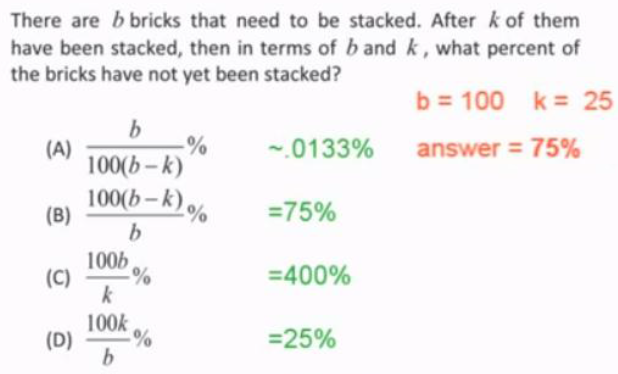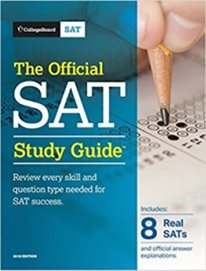
The Correct Way to Prepare for SAT Math
There are three key components to improving your score in SAT Math.
(1) Learning test taking strategies that are specific to the SAT.
(2) Practicing SAT math problems ten to twenty minutes per day for approximately three to four months.
(3) Taking at least four practice tests before test day, approximately one per month.
Let us discuss each of these three components in detail:
Strategy: If you have at least three months to prepare, you should learn between one and three SAT specific math strategies per week. Whenever you come across a problem where a specific strategy can be used, you should always attempt the problem using that strategy. In fact, I recommend trying to solve every practice problem in up to four ways:
(1) Using an SAT specific strategy
(2) The quickest way you can think of
(3) The way you would do it in school
(4) The easiest way for you
In many problems, some of these methods might be the same, and each of these methods might not be relevant to every problem. Nonetheless, this is the general guideline you should follow. Keep in mind that the actual answer to a given SAT problem is not important. You will never see that specific problem on the SAT. But it is important to learn as many techniques as possible. The more strategies, techniques, and methods you learn, the greater the increase you will see in both your current SAT score, and your level of mathematical maturity.
Here is an example of an SAT math problem being solved using the basic strategy of “picking numbers.”

Practice: If your SAT is less than four months away, set aside a block of time right now that you will dedicate to SAT math practice every single day! You should begin each study session by learning one new SAT specific strategy or quickly reviewing a strategy you already know. Recall that you are only learning between one and three new strategies each week, so on many days you will simply be quickly glancing over a strategy you already know. Keep this strategy in mind as you practice, and use it whenever possible.
Next you should choose one of the four topics: Heart of Algebra, Geometry and Trigonometry, Passport to Advanced Math, or Problem Solving and Data Analysis You should cycle through these topics, so that each day you are working on a different topic, and you are hitting each topic once or twice per week.
You should spend the first half of your study session reattempting problems from this topic that you have previously gotten wrong. If you get a problem right this time, you can discard it and never look at it again. If you still get it wrong, keep it marked off, and reattempt it again in another week or so. It is important that you wait at least a few days before reattempting a problem you got wrong – you want to give yourself a chance to forget the nature of that specific problem. This will ensure that you are actually solving the problem, and not just “recalling the solution.”
Redoing problems you get wrong is extremely important – more important than attempting new problems. This is what separates students that show dramatic improvement from students that show only average improvement. Remember, you learn from your mistakes, not your successes!
For the second half of your study session you should attempt problems from this topic that you haven’t tried before. Make sure you are working on problems of the appropriate level. For example, if you are struggling with Level 3 Geometry problems, then do not attempt Level 4 Geometry problems. You can work on those in a few weeks after you become more proficient in Level 3 Geometry.
Make sure you clearly mark off any questions you get wrong. It does not matter why you got it wrong – if you got it wrong, mark it off. I can’t emphasize this enough. Many students think that making a “careless error” is an excuse to never look at a specific problem again. But doing well on the SAT is all about eliminating careless errors! You will reattempt these “marked off” problems next time you come back to this topic. Remember to try to solve each problem in more than one way (see above).
Tests: You want to take about four practice tests before test day to make sure that you are implementing strategies correctly and using your time wisely under pressure. For this task you should use the College Board’s Official SAT Study Guide. Take one test every few weeks to make sure that you are implementing all the strategies you have learned correctly under timed conditions.
I recommend that you take your practice SATs on a Saturday or Sunday morning and make sure you time yourself correctly. Also mark off the questions you get wrong and throw them into the group of questions you will be reattempting at your short study sessions. This will make your time spent much more effective. Also, make sure you score these practice tests, and keep track of your scores to make sure you are showing improvement.
At first, you can just do the two math sections, but for at least your last two practice tests you should do the whole SAT in one sitting. I even like to add in an extra math section to simulate the experimental section of the SAT. This will ensure that you are practicing taking the test for the full length of the actual SAT.
How to learn strategies and find good practice problems: So I have already told you where to find practice tests, but where can you learn SAT specific math strategies and find daily practice problems? You can find these in the Get 800 Collection of SAT prep books. Click on the picture below for more information.
Click Play in the Video Below to Learn How to Prepare For SAT Math Effectively With Only 10 to 20 Minutes Of Practice Per Day
Best of luck,

Dr. Steve
Get 800


